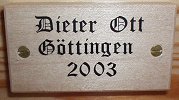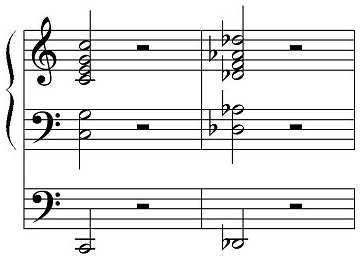Ott-Orgel
Version 2.00
This document describes a virtual organ for the programm Hauptwerk 2 from Martin Dyde (see http://www.crumhorn-labs.com/). The latest version with possible error corrections can be downloaded from http://orgel.datzko.ch/.
![]() Dieses Dokument gibt es auch auf Deutsch
Dieses Dokument gibt es auch auf Deutsch ![]() .
.
Instrument

Figure 1: Picture of the organ
The recorded organ was finished by Dieter Ott (Göttingen in Northern Germany) in the year 2003. It has 5 Stops on one manual (56 keys) with attached pedal (30 keys). The stops are labeled with Gedackt 8', Rohrflöte 4', Prinzipal 2', Quinte 1 1/3' and Oktave 1'. Die Tracker is completly mechanical.

Figure 2: Logo of the manufacturer
This instrument was build for a private person and is currently in private property.
Virtual Organ
Recording
The organ was recorded with a SASS-P MK II stereo boundry layer microphone. Using a Behringer Ultragain Pro preamplifier that also provided the phantomfeeding both channels were sampled using a Terratec DMX 6-fire 24/96-Soundcard with 24 Bit and 96 KHz, using Steinbergs WaveLab Lite Version 2.01a.
Every pipe of every register was recorded individually, at first each tone once and during the second take each tone twice directly after each other, to minimise any probems with the chiff. Additionally for every stop a C major and a D flat major chord was recorded to compare the complete sound. These cords are written down in figure 3.

Figure 3: Chords
At last some smaller pieces of organ music were recorded as well as 5 minutes of silence to be able to filter out the background noise of the blower as well as of the environment.
Processing
At first the background noise was removed from all files using the demo version of Cool Edit 2000 Version 1.1. To do this a 3 minute piece of silence was analysed for its frequencies and used as a filter. Surprisingly no mentionable loss in quality of the sound happened, although the blower sounded quite loud to me.
The files were then sampled down to 16 Bit, 44.1 KHz using WaveLab Lite Version 2.01a. They were also cut into pieces using Cool Edit 96 and the best recording of each pipe was selected. Some few pipes had to be borrowed from its neighbors, preferably from another recording, because they gave an unsatisfactory sound. This was only done with tones that were standing out very much, smaller changes in sound in some pipes were left for reasons of authenticity and liveliness of the sound:
|
||||||||||
Table 1: Borrowed Pipes |
After that they were tuned to 440 Hz using the Organ Stop Preparation Tool from Martin Dyde.
Because the organ was in a quite good shape concerning the sound further processings and tonal changes of the recording which Martin Dyde suggests in his recording guide were left out.
At last each individual pipe was trimmed with Zero-X Seamless Looper (with 30 ms space befor the beginning of the pipe sound to allow the chiff, 15 ms of this as fade in to avoid clicks, at the end approx. 120 ms space after the last noticable sound, at the end 30 ms fade out), looped (with at least 80% of the core sound as loop) and supplied with a release marker using Cool Edit 96, at the beginning of the end of the sound.
Together with the .organ file and this documentation the organ was finished.
Technical Requirements
The requirements are mostly set by the program Hauptwerk where version 1.21 is necessary. Specifically for this organ is the need of 313 Mb RAM. All the other requirements are rather at the lower end, because this organ only has 5 stops. Also for the interface only a resolution of 800x600 is necessary.
For optical reasons I suggest to install the font ClerestorySSK which is available for free on the internet, because it is quite similar to the writings on the organ.
Changes
1.0 -> 1.01
- Ott-Orgel.organ: little cosmetic corrections
- jpOtt-Orgel.organ: new, contributes by James Pressler, with twenty new divisionals, to make playing easier
1.01 -> 2.00
- 1.01 for Hauptwerk 1 is still up to date
- Version for Hauptwerk 2
- Most of the work for the Hauptwerk 2-version was thankfully done by Reiner Suikat (http://www.pipeloops.com/), who did this in a very professional manner.
License
Please note: This is only a translation (see §1.4).
§0 Intention of the license. This license is intended to serve the purpose of regulating the rights and obligations of the licensee. Because it is written by a non-expert, it is most probably incomplete and contains parts that are not up to juridical standards. Because of this the license is to be understood by its intentions. The licensee gets rights which draw some obligations with them. Whether the licensee uses these rights is up to himself, but if he refuses this license or parts of it, he may not take any of these rights.
§1 General things
§1.1 Matter. This license applies to the package "Ott-Orgel" and its usage, where the package "Ott-Orgel" is a processed recording of an organ which is prepared for the use with the program "Hauptwerk" and all the additional files. In the following the package will be only called "the package".
§1.2 Invalidity of individual declarations. Should a declaration of a paragraph of this license be invalid, all other declarations and paragraphes are still valid.
§1.3 No warranty. Because the rights are offered for no cost there is no right of warranty of any kind. Especially it is not guaranteed that this package is complete, finished or in any way usable. It is provided "as it is". Should the licensee or a third person have any financial, physical or other damage by this package, or should data get lost, the costs are to be carried by the licensee or the third person. The licenser gives the package to the licensee after his best knowledge and conciense.
§1.4 Translations. The german version of the license is valid. A english version of the license is provided to provide a easier understanding, but this translation has no legal consequences.
§2 Usage
§2.1 Installation on private computers. The licensee may install this package on as many private accessible computers as he likes, if each and every time the package is complete with this license.
§2.2 Installation on public accessible computers. The licensee may install this package on as many public accessible computers as he likes, if each and every time the package is complete with this license and in addition it is provided that at first third persons may copy the complete package and at second it is completly clear that all the files of this package belong together.
§2.3 Usage. The licensee may use this package to perform pieces of music privately and publicly. If a recording is made (be it through the internal recording function fo the program "Hauptwerk" or externally), this is also allowed. In this case a reference copy of the recording for the licenser is asked for, but voluntarily.
§2.4 Change. The licensee may not change the package. Should error corrections be necessary, the licenser will consider these and decide freely to do them or not.
§2.5 Usage of parts. Should the licensee want to use parts of this package (for example a stop or individual pipes) in another relation (for example in another package), he needs to have the permission of the licenser before doing so. Usually this will require the licensee to send a reference copy of the new package to the licenser after finishing it.
§3 Passing on
§3.1 Permission to pass on. This package may be passed on for no charge, if at first this passing on is for no charge or for a nominal copy fee, where it needs to be made clear to whom the package is passed on that this fee is for copying, and at second this package is complete and unchanged.
§3.2 Licence while passing on. Who gets this package passed on needs to accept the license of the licenser. Who passes the package on is not the new licenser, but the initial licenser.
§3.3 Combination with other products. It is not allowed to sell this package together with other products if this package enhances the value of that product much.
Links
http://orgel.datzko.ch/ - the homepage of this package.
Hauptwerk - the program this package was written for. You can get the Organ Stop Preparation Tool on request there, too.
Syntrillium Cool Edit 96 and Syntrillium Cool Edit 2000 Version 1.1 - audio editor, a demo version was enough functionality for this organ. Syntrillium was bought by Adobe.
Steinberg WaveLab Lite Version 2.01a - audio editor, I got it for free with my soundcard.
Zero-X Seamless Looper - audio editor, with an extremely reliable auto search function for loops.
ClerestorySKK - a place where you can get this font.
The following links contain reviews or demos of the Ott-Orgel.
Virtually Baroque - James Pressler made two virtual concerts with the Ott-Orgel, the Ott-Orgel was "Featured Instrument of the Week", also.
Pipeloops - Reiner Suikat offers various services around samples (especially for Hauptwerk).